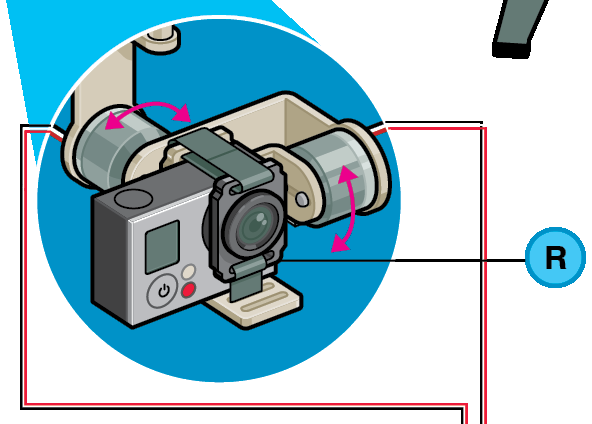
Chapter 3. Anatomy of a Drone
Motor
Usually a brushless electric “outrunner” type, which is more efficient, more reliable, and quieter than a brushed motor (Figure 3-1).

Figure 3-1. Motor
Motor Mount
Sometimes built into combination fittings with landing struts (Figure 3-2).

Figure 3-2. Close-up of motor mount
Landing Gear and Boom
Designs that need high ground clearance may adopt helicopter-style skids mounted directly to the body, while designs with no hanging payload may omit landing gear altogether (Figure 3-3).

Figure 3-3. Landing gear and boom
Main Body
Central “hub” from which booms radiate like spokes on a wheel. Houses battery, avionics, cameras, and sensors (Figure 3-4).

Electronic Speed Controller (ESC)
Converts DC battery power into three-phase AC for driving brushless motors (Figure 3-5).

Figure 3-5. Electronic speed controller (H) and radio receiver (K)
Flight Controller
Interprets input from receiver, GPS module, battery monitor, and onboard sensors. Regulates motor speeds, via ESCs, to provide steering, as well as triggering cameras or other payloads. Controls autopilot and other autonomous functions (Figure 3-6).

Figure 3-6. Flight controller computer
GPS Module
Often combines GPS receiver and magnetometer to provide latitude, longitude, elevation, and compass heading from a single device (Figure 3-7).

Figure 3-7. GPS module
Receiver
Often a standard R/C radio receiver unit. The minimum number of channels needed to control a quad is four, but five is usually recommended (as seen in Figure 3-5).
Antenna
Depending on your receiver, may be a loose wire whip or helical “rubber ducky” type (Figure 3-8).

Figure 3-8. Antenna
Battery
Lithium polymer (LiPo) batteries offer the best combination of energy density, power density, and lifetime on the market (Figure 3-9).

Figure 3-9. Battery (M) and battery monitor (N)
Gimbal Controller
Allows control of direct-drive brushless gimbal motors as if they were standard hobby servos (Figure 3-10).

Figure 3-10. Gimbal controller
Camera
GoPro or other compact HD video unit with onboard storage. Real-time streaming is possible with special equipment (Figure 3-11).

